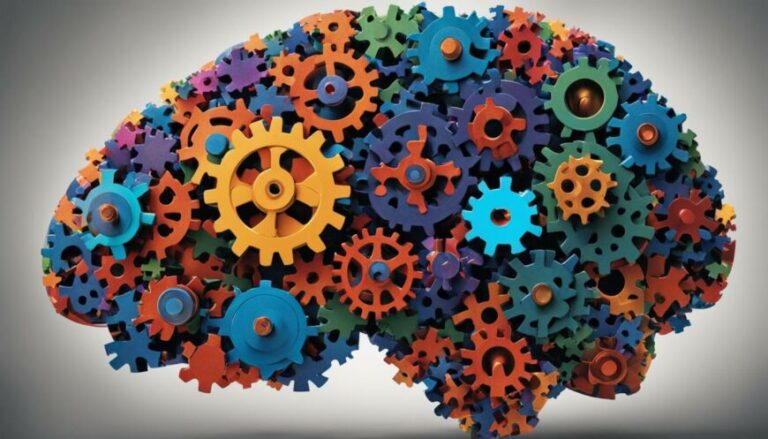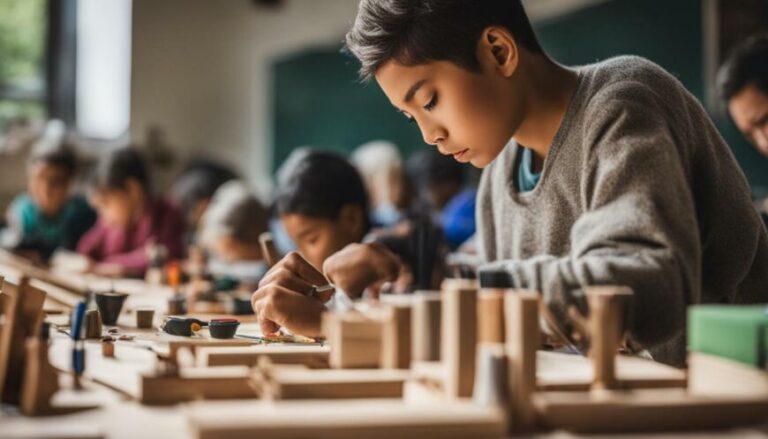Have you ever struggled to understand a concept, even after reading about it extensively? If so, you’re not alone. Many learners find that traditional methods of learning, such as reading, listening, or watching, aren’t always enough to fully grasp a topic. That’s where multimodal learning comes in.
Multimodal learning is a teaching approach that combines multiple styles of learning to enhance comprehension and retention. By engaging learners through various modalities, such as visual aids, hands-on activities, and audio instructions, educators can leverage different learning styles to create a more holistic and effective learning experience.
At its core, multimodal learning is all about catering to diverse learning preferences and maximizing learning outcomes. Whether you’re a kinesthetic learner who prefers hands-on activities or an auditory learner who benefits from listening to lectures, multimodal learning offers something for everyone.
Key Takeaways
- Multimodal learning combines various styles of learning to enhance comprehension and retention.
- It caters to diverse learning preferences and maximizes learning outcomes.
- Modalities used in multimodal learning include visual aids, hands-on activities, and audio instructions.
- Multimodal learning is an effective teaching approach in educational settings.
- By understanding multimodal learning, educators can create a more holistic and effective learning experience for students.
Understanding Multimodal Learning
Multimodal learning involves the use of multiple sensory modalities to facilitate learning. By incorporating different modalities, educators can create a more engaging and effective learning experience for students. Here are some multimodal learning techniques and examples:
| Modality | Techniques | Examples |
|---|---|---|
| Visual | Images, videos, infographics, mind maps | Using a diagram to illustrate the water cycle, watching a video on the history of World War II |
| Auditory | Lectures, podcasts, music, sound effects | Listening to a biology lecture, using audio prompts in a language-learning app |
| Kinesthetic | Role-playing, simulations, hands-on activities | Acting out a scene from Shakespeare, building a model of the solar system |
By using a combination of these techniques, learners can engage with information in a more meaningful way. For example, a student learning about the respiratory system may watch a video that shows how air enters the lungs, listen to an explanation of how oxygen is absorbed, and then participate in a hands-on activity where they build a model of the respiratory system.
Overall, multimodal learning offers a versatile and engaging approach to education that caters to different learning preferences and maximizes learning outcomes.

There are several models and strategies that educators use to implement multimodal learning techniques in the classroom. Understanding these models can help you choose the most effective approach for your students.
One such model is the ADDIE model, which stands for Analysis, Design, Development, Implementation, and Evaluation. This model helps educators create a step-by-step plan for designing and implementing effective multimodal learning experiences. It begins with analyzing the needs of learners and designing a curriculum that meets those needs. The development stage involves creating the learning materials, while implementation involves delivering those materials to students. Finally, evaluation involves assessing the effectiveness of the learning experience and making necessary adjustments.
Another popular model is the VARK model, which categorizes learners into four types based on their learning preferences: visual, auditory, reading/writing, and kinesthetic. Educators can use this model to tailor their teaching approach to cater to each student’s preferred learning style. For example, visual learners may benefit from diagrams, videos, and images, while kinesthetic learners may benefit from hands-on activities.
When implementing multimodal learning strategies, it’s essential to create a dynamic and engaging learning environment. One effective strategy is to use gamification, which involves incorporating game-like elements such as points, rewards, and challenges into the learning experience. This approach can help increase motivation and engagement, leading to better learning outcomes.

Overall, understanding the different models and strategies of multimodal learning can help you create a comprehensive and effective learning experience for your students. By combining different modalities and catering to diverse learning preferences, you can improve engagement and retention, leading to better learning outcomes.
The Benefits of Multimodal Learning
There are numerous benefits to incorporating multimodal learning in education. By utilizing different modalities, such as visuals, audio, and kinesthetic activities, learners can enhance their understanding and retention of information.
One of the key benefits of multimodal learning is increased engagement. By catering to different learning styles, learners are more likely to stay focused and interested in the learning material. This leads to better participation and improved learning outcomes.
Another benefit is improved retention. When information is presented through multiple modalities, it becomes easier to remember and recall. This is because the brain is more likely to form multiple connections to the information, creating a stronger memory trace.
Additionally, multimodal learning can enhance critical thinking skills. By presenting information through different modalities, learners are encouraged to make connections and think critically about the material. This leads to a deeper understanding and better problem-solving abilities.
Overall, incorporating multimodal learning in the classroom can lead to better learning outcomes and improved engagement. By utilizing different modalities, educators can cater to diverse learners and create a comprehensive learning environment.
Implementing Multimodal Learning in the Classroom
If you want to enhance learning outcomes in your classroom, embracing multimodal learning strategies is a must. By catering to different learning preferences, multimodal learning creates a more inclusive learning environment that maximizes student engagement. Here are some practical strategies you can implement:
- Use visuals like diagrams, charts, photos, and videos to supplement textual content and make abstract concepts more tangible.
- Implement audio elements like podcasts, music, and sound bites to help learners who learn best through auditory inputs.
- Create kinesthetic activities such as role-playing, simulations, and hands-on experiments for learners who benefit from a more tactile approach to learning.
- Encourage peer collaboration and discussions to facilitate social and emotional learning and reinforce learning outcomes.
It’s important to remember that multimodal learning is not about simply incorporating several learning methods in a haphazard way. Instead, it’s about designing a deliberate and coherent learning experience that caters to different learners’ needs.

For example, if you’re teaching a history lesson, you can use a multimedia approach to engage learners with different learning styles. You can include videos showcasing historical events, interactive maps highlighting important locations, and even simulations where learners can assume the roles of historical figures. By creating a multimodal learning experience that combines visual, audio, and kinesthetic elements, you’ll create an immersive and engaging learning experience that caters to diverse learners.
Implementing multimodal learning strategies doesn’t just benefit students; it can also enhance your own teaching skills and creativity. By experimenting with different modalities and techniques for multimodal learning, you’ll become a more versatile and dynamic educator.
Multimodal Learning and Cognitive Science
In recent years, multimodal learning has gained significant attention from cognitive science researchers. At its core, multimodal learning is based on the theory that individuals have different learning preferences, and that using multiple modalities can enhance learning outcomes.
According to research, multimodal learning is effective because it allows learners to engage multiple areas of the brain simultaneously. This can lead to improved retention and recall of information, as well as enhanced critical thinking skills. For example, a student who learns about a historical event through a combination of visuals and text may have a better understanding of the context and significance of the event.
In addition to its impact on memory and learning outcomes, multimodal learning has also been shown to be particularly useful for learners with learning disabilities. By incorporating a variety of modalities, learners with auditory, visual, or kinesthetic processing issues can better engage with the material and improve their understanding and retention.

Overall, the benefits of multimodal learning are clear. By incorporating a variety of modalities, learners can engage more fully with the material and improve their learning outcomes. Whether in a classroom or professional setting, multimodal learning is a powerful tool that can help individuals reach their full potential.
Enhancing Learning with Multimodal Approaches
Now that you are familiar with multimodal learning and its benefits, let us explore some specific techniques and examples of how to incorporate it into your teaching. Here are some effective multimodal learning techniques to consider:
- Visual aids: Use images, videos, graphs, and diagrams to supplement your lectures. These visuals can help students comprehend complex concepts and retain information better. For example, when teaching history, you can show pictures or videos of historical events and artifacts to make the subject come alive.
- Audio: Use podcasts, recorded lectures, and soundscapes to engage auditory learners. For example, when teaching languages, you can play audio recordings of native speakers to help students learn pronunciation and intonation.
- Kinesthetic activities: Engage kinesthetic learners with hands-on activities, such as role-playing, simulations, and experiments. These activities can help students connect abstract ideas to real-world experiences and improve their critical thinking skills. For example, when teaching science, you can conduct experiments and demonstrations to help students understand scientific principles.
Here are some real-world examples of how multimodal learning has enhanced the learning experience:
“In my math class, our teacher used videos to explain complex equations and formulas. Seeing the visuals helped me understand the concepts better than just reading the textbook.” – Sarah, high school student
“When teaching about ecosystems, I take my students on a nature walk and have them collect samples of plants and insects. Then, we create a diorama using the samples and discuss how the different species interact with each other. This hands-on activity helps my students understand the complex relationships in an ecosystem.” – Mr. Johnson, middle school science teacher
Remember, there are many ways to incorporate multimodal learning into your teaching. The key is to be creative and cater to different learning preferences. By adopting multimodal learning strategies, you can enhance the learning experience and promote better comprehension and retention.

Overall, multimodal learning is a highly effective approach to education that can benefit both learners and educators. By combining different modalities such as visuals, audio, and kinesthetic activities, students can enhance their understanding and retention of course material.
Not only does multimodal learning cater to diverse learning preferences, but it also promotes critical thinking skills and engagement in the classroom. It’s no wonder that more and more educators are embracing multimodal learning as a teaching strategy.
When implementing multimodal learning in the classroom, educators must consider the individual needs and preferences of their students. By creating a learning environment that caters to all learners, educators can ensure that every student has the opportunity to succeed.
Finally, cognitive science supports the effectiveness of multimodal learning approaches and validates their impact on memory and learning outcomes. From improved retention and engagement to enhanced critical thinking skills, the benefits of multimodal learning are clear.
Embracing Multimodal Learning for Maximum Learning Outcomes
By adopting multimodal learning strategies, educators can ensure that their students have the tools they need to succeed. From providing visual aids to incorporating hands-on activities, multimodal learning creates a comprehensive learning experience that caters to diverse learners.
It’s time to embrace multimodal learning in our schools and classrooms. By doing so, we can ensure that all students have the opportunity to reach their full potential.
FAQ
Q: What is multimodal learning?
A: Multimodal learning refers to the use of multiple sensory modalities, such as visuals, audio, and kinesthetic activities, to enhance learning and comprehension. By incorporating different styles of learning, multimodal learning aims to engage learners more effectively and promote deeper understanding.
Q: What are some examples of multimodal learning techniques?
A: Examples of multimodal learning techniques include using multimedia presentations that combine visuals and audio, incorporating hands-on activities and experiments, utilizing interactive technology, and implementing group discussions or collaborative projects that involve different modes of communication.
Q: How can multimodal learning be implemented in the classroom?
A: To implement multimodal learning in the classroom, teachers can create a diverse learning environment by incorporating visuals, videos, and interactive technology, providing hands-on activities and experiments, encouraging group discussions and collaborative projects, and offering a variety of assessment methods to cater to different learning preferences and styles.
Q: What are the benefits of multimodal learning?
A: Multimodal learning has several benefits, including increased engagement and motivation, improved retention and comprehension, enhanced critical thinking and problem-solving skills, and a greater ability to transfer knowledge to real-world situations. It also helps cater to different learning styles and preferences, ensuring that all students can effectively access and process information.
Q: How does cognitive science support multimodal learning?
A: Cognitive science research shows that incorporating multiple sensory modalities in the learning process enhances memory encoding and retrieval. By engaging different parts of the brain through visuals, auditory cues, and kinesthetic activities, multimodal learning improves information retention and promotes better recall and understanding.
Q: Can you provide examples of how multimodal learning has enhanced the learning experience?
A: Yes! Multimodal learning has been utilized in various educational settings to enhance the learning experience. For example, using multimedia presentations with visuals, audio, and interactive elements has been shown to increase student engagement and improve comprehension. Hands-on activities and experiments can make abstract concepts more tangible and relatable, leading to better understanding. Collaborative projects involving different modes of communication, such as visual presentations and group discussions, encourage critical thinking and communication skills.
Q: Why is it important to adopt multimodal learning strategies?
A: It is important to adopt multimodal learning strategies because learners have diverse preferences and styles of learning. By incorporating multiple sensory modalities, educators can cater to these differences and create a more inclusive and effective learning environment. Multimodal learning also aligns with how our brains naturally process and retain information, leading to improved learning outcomes.






